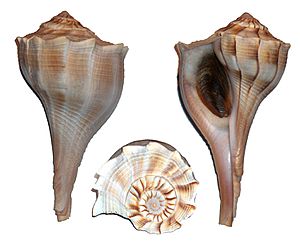Lightning whelk facts for kids
Quick facts for kids Sinistrofulgur perversum |
|
|---|---|
 |
|
| Sinistrofulgur perversum found in France, with the operculum in place | |
| Scientific classification | |
| Kingdom: | |
| Phylum: | |
| Class: | |
| (unranked): |
clade Caenogastropoda
clade Hypsogastropoda clade Neogastropoda |
| Superfamily: |
Buccinoidea
|
| Family: |
Busyconidae
|
| Genus: |
Sinistrofulgur
|
| Species: |
S. perversum
|
| Binomial name | |
| Sinistrofulgur perversum (Linnaeus, 1758)
|
|
| Synonyms | |
|
|
The lightning whelk, also known by its scientific name Sinistrofulgur perversum, is a very large sea snail. It is a type of whelk, which is a mollusc found in the ocean. These snails are predators, meaning they hunt and eat other animals.
One of the most interesting things about the lightning whelk is its shell. Unlike most snails, its shell coils to the left. This is called a sinistral shell. Most snail shells coil to the right.
Contents
Where Do Lightning Whelks Live?
This sea snail lives in the ocean waters off the southeastern coast of North America. You can find them from New Jersey all the way south to Florida and into the Gulf of Mexico.
What Is Their Home Like?
Lightning whelks like to live in shallow bays. They prefer areas with sandy or muddy bottoms. This type of soft ground is perfect for them to move around and find food.
What Do Lightning Whelks Eat?
Lightning whelks are carnivores, which means they eat meat. Their main food source is bivalves. Bivalves are animals like clams and oysters that have two shells. The whelk uses a special long tube called a proboscis to eat the soft parts of these bivalves.
How Is It Different from Other Whelks?
The lightning whelk shares some features with another snail called the knobbed whelk (Busycon carica). However, there are a few key differences:
- Shell Coiling: Lightning whelks have shells that coil to the left (sinistral). Knobbed whelks have shells that coil to the right (dextral).
- Shell Shape: The lightning whelk's shell has a lower top part, called a spire. Its bumps, or "knobs," are also usually smaller than those on a knobbed whelk.
- Daily Habits: Lightning whelks are active during the day (diurnal). Knobbed whelks are active both day and night.
- Feeding Spots: When looking for food on muddy areas, lightning whelks tend to stay in deeper water than knobbed whelks.
How Have People Used Lightning Whelks?
For thousands of years, Native American people used lightning whelks. They ate the snails as food. They also used the strong shells for many things. These included tools, decorations, containers, and even jewelry like shell gorgets.
Some people believe that the lightning whelk's left-coiling shell made it a special or sacred object. For example, a very old human skeleton, known as the Minnesota Woman (who lived around 6000 BCE), was found wearing a Sinistrofulgur perversum shell.
Today, the lightning whelk is important enough to be recognized officially. It is the State Shell of Texas.
Gallery
See also
 In Spanish: Caracol toro o chiva para niños
In Spanish: Caracol toro o chiva para niños






